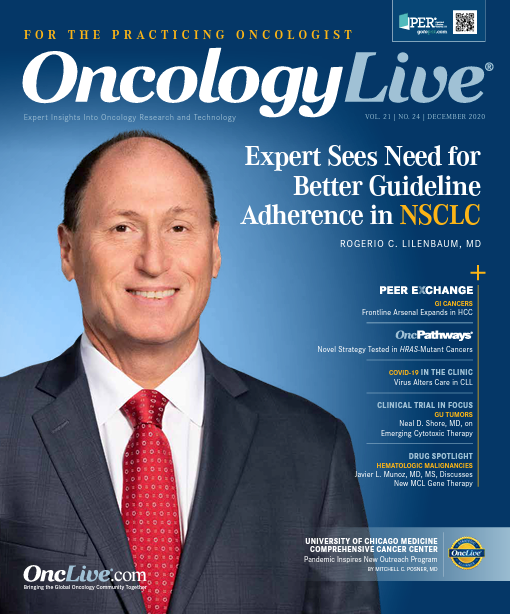Publication
Article
Frontline Treatment Arsenal Expands in Advanced HCC
Author(s):
Although rates of hepatocellular carcinoma incidence started to plateau in 2013, many cases continue to be diagnosed at more advanced stages, especially in patients without liver disease.
Tanios Bekaii-Saab, MD

Hepatocellular carcinoma (HCC) is the fourth most-common cause of cancer-related death worldwide.1 Although rates of HCC incidence started to plateau in 2013, many cases continue to be diagnosed at more advanced stages, especially in patients without liver disease.2,3 Despite the number of HCC cases, treatment options for patients with advanced disease remain sparse. However, several new drug approvals in the frontline setting and the initiation of numerous trials exploring novel strategies are seeking to change the tides for aggressive cancer. During an OncLive Peer Exchange®, a panel of liver cancer experts reviewed the available systemic treatments and how they choose between them. They also shared their thoughts on some of the ongoing clinical trials that have the potential to reshape the treatment landscape in the coming years.
FDA-Approved Frontline Treatments
There are 3 FDA-approved frontline treatment options for patients with unresectable HCC and Child-Pugh class A liver function: tyrosine kinase inhibitor (TKI) sorafenib (Nexavar), approved in 2008; TKI lenvatinib (Lenvima), approved in 2018; and immunotherapy with atezolizumab (Tecentriq) and bevacizumab (Avastin), approved in 2020.4-6 “Most of us will remember the days before sorafenib, where Megace [megestrol acetate], tamoxifen, or another unproven agent would be used because we were so desperate for systemic agents in this disease,” Tanios S. Bekaii-Saab, MD, said. He noted that sorafenib was approved based on data from the SHARP trial (NCT00105443), which showed an approximate 3-month benefit with sorafenib versus placebo in median overall survival (OS; 10.7 vs 7.9 months) and median time to radiologic progression (5.5 vs 2.8 months).7 Although sorafenib was the first drug to show a survival benefit in patients with advanced HCC, “the dose was challenging, and everyone came up with their own dosing schedule and regimen [to reduce the risk of toxicities],” Bekaii-Saab said, adding that there were many attempts to find better-tolerated and more-efficacious agents, but little progress was made until 10 years later when lenvatinib was approved based on data from the REFLECT trial (NCT01761266).8
Investigators of REFLECT, a phase 3, international, multicenter, open-label noninferiority study randomized 954 patients with previously untreated metastatic or unresectable HCC to lenvatinib (n = 478) or sorafenib (n = 476).8 The median OS was 13.6 months with lenvatinib compared with 12.3 months with sorafenib (HR, 0.92; 95% CI, 0.79-1.06). In addition to its noninferior survival, lenvatinib demonstrated an improved median progression-free survival (PFS; 7.3 vs 3.6 months; HR, 0.64; 95% CI, 0.55-0.75). Based on these data and its tolerable safety profile, lenvatinib was the favored regimen until the approval of the atezolizumab/bevacizumab combination, Bekaii-Saab noted.9
The approval was based on data from IMbrave150 (NCT03434379), a global, phase 3 trial that randomly assigned 501 treatment-naïve patients with unresectable HCC to receive atezolizumab/bevacizumab (n = 336) or sorafenib (n = 165).9 The primary end points included OS and PFS in the intention-to-treat population, as assessed by independent review. “This study came and hit every single one of the end points, and resulted in very impressive hazard ratios,” Bekaii-Saab said. At the time of the primary analysis in August 2019, the HR for death with the immunotherapy combination versus sorafenib was 0.58 (95% CI, 0.42-0.79; P < .001). Although the OS has yet to be reported, the 12-month OS rate was 67.2% (95% CI, 61.3%-73.1%) in the atezolizumab/bevacizumab arm versus 54.6% (95% CI, 45.2%-64.0%) in the sorafenib arm. The median PFS was 6.8 months (95% CI, 5.7-8.3) and 4.3 months (95% CI, 4.0-5.6) in the respective groups (HR, 0.59; 95% CI, 0.47-0.76; P < .001).9
Peter R. Galle, MD, PhD

“Most importantly, [atezolizumab/bevacizumab] preserves and improves the quality of life [QOL] of the patients,” Bekaii-Saab said, noting that the study also looked at various patient-reported outcomes as secondary end points. Patients completed the European Organisation for Research and Treatment of Cancer (EORTC) QLQ-C30 and the EORTC QLQ-HCC18 questionnaires before treatment, every 3 weeks during treatment, and every 3 months after treatment discontinuation or disease progression.10 More than 90% of patients completed the questionnaires. Compared with sorafenib, the immunotherapy combination delayed time to deterioration (TTD) of patient reported QOL, physical functioning, and role functioning (TABLE10). Atezolizumab/bevacizumab also delayed TTD in patient-reported appetite loss, fatigue, pain, and diarrhea, with fewer patients in the immunotherapy arm versus the sorafenib arm experiencing clinically meaningful deterioration in any of these symptoms.10
“They have a much better quality of life, and they can maintain their work and activity. In a situation where we are talking about palliation, although their life span is still limited, it makes quite a difference whether their quality of life is good or impaired, and this is very in favor of this combination in terms of improvement of quality of life and other aspects,” Peter R. Galle, MD, PhD, said.
TABLE. Patient-Reported Outcomes From the IMbrave150 Trial

Selecting Between Frontline Treatments
The panelists agreed that the standard of care for fit patients with Child-Pugh A liver function and advanced HCC is now atezolizumab/bevacizumab; however, Pierre Gholam, MD, noted that bleeding is an issue with certain patients. “[Risk of bleeding] would probably be one of the top 2 or 3 most-asked questions when it comes to atezolizumab/bevacizumab therapy,” Gholam said. “How might one manage or mitigate the risk of bleeding in the setting of cirrhosis? An important thing to remember and consider is that the risk of having varices or, perhaps more importantly, large varices, increases as the Child-Pugh score increases. Someone with Child-Pugh score C is much more likely to have large varices than patients with ChildPugh B, and they are much more likely to have varices than patients with Child-Pugh A.” But Gholam said the risk of progression for variances is approximately 7% to 10% and that they are compounded by other factors such as uncontrolled alcohol use. Addressing these variances without delaying treatment to mitigate the risk of bleeding would include screening for the presence of large variances rapidly.
R. Katie Kelley, MD

Treatment decisions are much more challenging in patients who are not candidates for this regimen. “If I were asked to summarize the patients for whom we wouldn’t use atezolizumab plus bevacizumab, I would generally categorize them into 3 or 4 different types,” R. Katie Kelley, MD, said. These patients would include those who were excluded from the IMbrave150 trial, such as those with active varices or who are at higher risk for bleeding varices or other types of bleeding based on their screening, endoscopy, or other clinical factors; patients with ChildPugh B liver function; and patients with autoimmune disease or history of transplantation, she said. “When making [treatment decisions] for these groups of patients who aren’t good candidates for atezolizumab plus bevacizumab, we can look to lenvatinib and sorafenib.”
When deciding between sorafenib and lenvatinib for these patients, Kelley said she considers the collective clinical trial data, including subgroup analyses. “If it’s a patient with Child-Pugh B liver function, then it’s important to note that we don’t have prospective data for lenvatinib…[so] I’m more likely to choose sorafenib with an empiric starting dose reduction based on some of the VA [US Department of Veterans Affairs] data that have been published,” she said. Although Kelley said it may be reasonable to try a checkpoint inhibitor–based regimen in some patients with autoimmune deficiencies, if there is close monitoring, this does not apply to patients with active disease requiring immunosuppression or those who received a liver transplant. She noted that the risk of graft loss is too high in the latter group, with studies reporting a risk of rejection greater than 30%. In such patients, she said sorafenib and lenvatinib are both reasonable choices and that the adverse effects profiles of these agents should be considered and weighed against the patient’s comorbidities and medications. “Lenvatinib does have more QTc [corrected QT interval] prolongation risk than sorafenib,” Kelley said. Subsequently, if a patient is on a medication that may interact with lenvatinib to cause this complication, she said she would select sorafenib.
Another common question, Kelley said, is whether treatment decisions may hinge on patients’ viral status, notably whether they are infected with hepatitis B versus hepatitis C. “[If you] look at the REFLECT trial of sorafenib versus lenvatinib and the forest plots, the survival is similar, and there was no significant difference in the subset analyses for hepatitis B versus hepatitis C. There was a trend toward benefit for lenvatinib for time to progression and PFS for both viral subgroups; perhaps it was more pronounced for those with hepatitis B,” she said. Kelley cautioned that subgroup analyses are not adequately powered to provide definitive answers, but they do provide some insights. “Overall, I would say that we don’t have enough data to make a strong decision based on viral status. Perhaps lenvatinib should be favored in patients with hepatitis B, but we can’t choose the drug based on hepatitis C status 1 way or the other. It should be based more on comorbidities than viral status,” she said.
Richard S. Finn, MD

A Role for Nivolumab?
“There is a lot of exciting stuff coming down the pike,” moderator Richard S. Finn, MD, said, noting that the frontline treatment landscape for HCC is poised to continue rapidly evolving after a decade of stagnation. One exciting approach being explored is combining a TKI with a checkpoint inhibitor. This combination is being assessed in 2 phase 3 trials: LEAP-002 (NCT03713593) and COSMIC-312 (NCT03755791), the latter of which is still recruiting patients.
LEAP-002 is comparing lenvatinib and pembrolizumab (Keytruda) with lenvatinib monotherapy. Data are not yet available, but the combination showed promise in other clinical trials, with Finn noting response rates of approximately 36% in the frontline treatment of patients with Child-Pugh A. He also noted that thus far the safety data for the combination look consistent with single-agent lenvatinib or single-agent pembrolizumab.
The COSMIC-312 trial is comparing the safety and efficacy of first-line cabozantinib (Cabometyx) plus atezolizumab with sorafenib in patients with advanced HCC and will include a single-agent cabozantinib arm for comparison with single-agent sorafenib.13 Cabozantinib is already approved as a monotherapy in patients previously treated with sorafenib.13 COSMIC-312 is randomly assigning approximately 740 eligible patients 2:1:1 to receive the combination (approximately 370 patients) or 1 of the single agents (estimated 185 patients in each arm).13 “[The hypothesis is] based on the rationale that cabozantinib has some interesting tyrosine kinase inhibition that may be immunomodulatory in a different way,” Kelley said. An article Kelley coauthored in Future Medicine notes that cabozantinib targets multiple receptor kinases involved in angiogenesis, tumor growth, and metastasis, including VEGF, MET, and the TAM family of receptor kinases (TYRO3, AXL, MER).13 Kelley said that the cabozantinib/atezolizumab combination recently showed promising results in renal cell carcinoma, with an objective response rate of nearly 50%.13,14
“The premise that not only is there a potential for additive benefit or synergy when you combine antiangiogenic therapy with immuno therapy, but these TKI therapies can also be immunomodulatory in the microenvironment and promote an immune response in other ways, such as by inhibiting other kinase pathway signaling and conferring potential for additive effect, being active drugs in their own right,” Kelley said.
Two phase 3 trials also are exploring another immunotherapy approach that combines CTLA-4 inhibition with a checkpoint inhibitor. Kelley noted that the rationale for this combination stems from promising results in other solid tumors, including lung cancer and melanoma, which showed synergy in the immune response. The trials examining this combination in patients with advanced HCC include HIMALAYA (NCT03298451) and CheckMate 9DW (NCT04039607), the latter of which is still recruiting patients.
“There are now 4 ongoing phase 3 studies in the frontline setting, after the approval for atezolizumab/bevacizumab, which speaks to the fact that there’s been incredible interest and excitement in liver cancer,” Finn said. “Having been in the space for some time, it’s exciting to be able to sit down with a patient and tell them all the great options we have that are improving survival and that we can expect responses to their tumor,” he said.
References
- Yang JD, Hainaut P, Gores GJ, Amadou A, Plymoth A, Roberts LR . A global view of hepatocellular carcinoma: trends, risk, prevention and management. Nature Rev Gastroenterol Hepatol. 2019;16(10):589-604. doi:10.1038/s41575-019-0186-y
- Shiels MS, O’Brien TR. Recent decline in hepatocellular carcinoma rates in the United States. Gastroenterology. 2020;158(5):1503-1505.e2. doi:10.1053/j.gastro.2019.12.030
- Tejeda-Maldonado J, García-Juárez I, Aguirre-Valadez J, et al. Diagnosis and treatment of hepatocellular carcinoma: an update. World J Hepatol. 2015;7(3):362-376. doi:10.4254/wjh.v7.i3.362
- Lang L. FDA approves sorafenib for patients with inoperable liver cancer. Gastroenterol. 2008;134(2):379. doi:10.1053/j.gastro.2007.12.037
- FDA approves lenvatinib for unresectable hepatocellular carcinoma. FDA. August 16, 2018. Accessed November 23, 2020. https://www.fda.gov/drugs/resources-information-approved-drugs/fda-approves-lenvatinib-unresectable-hepatocellular-carcinoma
- FDA approves atezolizumab plus bevacizumab for unresectable hepatocellular carcinoma. FDA. Updated June 1, 2020. Accessed November 23, 2020. https://www.fda.gov/drugs/drug-approvals-and-databases/fda-approves-atezolizumab-plus-bevacizumab-unresectable-hepatocellular-carcinoma
- Llovet JM, Ricci S, Mazzaferro V, et al; SHARP Investigators Study Group. Sorafenib in advanced hepatocellular carcinoma. N Engl J Med. 2008;359(4):378-390. doi:10.1056/NEJMoa0708857
- Kudo M, Finn RS, Qin S, et al. Lenvatinib versus sorafenib in first-line treatment of patients with unresectable hepatocellular carcinoma: a randomised phase 3 non-inferiority trial. Lancet. 2018;391(10126):1163-1173. doi:10.1016/S0140-6736(18)30207-1
- Finn RS, Qin S, Ikeda M, et al; IMbrave150 Investigators. Atezolizumab plus bevacizumab in unresectable hepatocellular carcinoma. N Engl J Med. 2020;382(20):1894-1905. doi:10.1056/NEJMoa1915745
- Galle PR, Finn RS, Qin S, et al. Patient-reported outcomes (PROs) from the phase III IMbrave150 trial of atezolizumab (atezo) + bevacizumab (bev) vs sorafenib (sor) as first-line treatment (tx) for patients (pts) with unresectable hepatocellular carcinoma (HCC). J Clin Oncol. 2020;38(suppl 4):476. doi:10.1200/JCO.2020.38.4_suppl.476
- Opdivo. Prescribing information. Bristol-Myers Squibb; 2020. Accessed November 23, 2020. https://www.accessdata.fda.gov/drugsatfda_docs/label/2020/125554s071lbl.pdf
- NCCN. Clinical Practice Guidelines in Oncology. Hepatobiliary cancers, version 5.2020. Accessed November 23, 2020. https://www.nccn.org/professionals/physician_gls/pdf/hepatobiliary.pdf
- Kelley RK, Oliver JW, Hazra S, et al. Cabozantinib in combination with atezolizumab versus sorafenib in treatment-naive advanced hepatocellular carcinoma: COSMIC-312 Phase III study design. Future Oncol. 2020;16(21): 1525-1536. doi:10.2217/fon-2020-0283
- Pal S, Tsao CK, Suarez C, et al. Cabozantinib (C) in combination with atezolizumab (A) as first-line therapy for advanced clear cell renal cell carcinoma (ccRCC): results from the COSMIC-021 study. Ann Oncol. 2020;31(suppl 4):S554. doi:10.1016/j.annonc.2020.08.774
- FDA grants accelerated approval to nivolumab and ipilimumab combination for hepatocellular carcinoma. FDA. Updated March 11, 2020. Accessed November 23, 2020. https://www.fda.gov/drugs/resources-information-approved-drugs/fda-grants-accelerated-approval-nivolumab-and-ipilimumab-combination-hepatocellular-carcinoma










